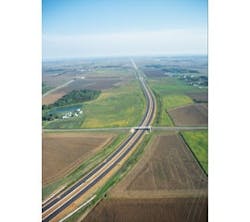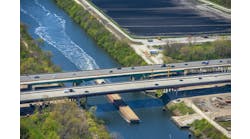Project: I-69 Evansville to Indianapolis Corridor, Sections 1-3
Location: Evansville, Ind., to Crane Ind.
Owner: Indiana DOT
Designers: American Consulting; ACE; Beam, Longest & Neff; Bernardin Lockmueller & Assoc.; Parsons Brinckerhoff; Wilbur Smith
Contractors: Multiple
Cost: $620 million
Start Date: Oct. 1, 2009
Completion Date: Nov. 19, 2012
Bat around
Indiana makes room for I-69 highway and for bats
Constructing I-69 through 67 miles of southwest Indiana involved overseeing 15 construction contracts simultaneously building 268 lane-miles of interstate, 132 bridges and seven interchanges.
The project used 114,000 cu yd of structural concrete and more than 47 million lb of reinforcing steel in the bridges.
The Indiana Department of Transportation (INDOT) allowed the contractors to decide whether to bid concrete or asphalt pavement in their sections, depending on geotechnical conditions. The result was more competitive bid prices and savings of $65.3 million for INDOT, compared with traditional pavement bidding.
Contractors constructed 50.2 centerline miles of concrete pavement and the balance in asphalt. Some sections feature concrete lanes with asphalt shoulders.
Some southwest Indiana citizens worried that I-69 might disturb the habitat of the Indiana bat, a small mammal about the size of a small mouse but with a wingspan of up to 101?2 in. The bats give birth among the trees and hibernate in caves in southern Indiana and 20 other states. About 10% of the world’s population of Indiana bats live in Indiana. Groups such as Citizens for Appropriate Rural Roads feared the construction would harm the federally endangered species.
INDOT led weekly meetings between INDOT’s environmental services, INDOT’s I-69 project managers, design consultants and the lead environmental consultant. As part of INDOT’s mitigation efforts, the agency purchased several times more land for mitigation than it did for the roadway itself.
“Some of the land is already pristine: forests, streams or wetlands. As such, we’re purchasing a preservation easement in perpetuity on the property,” Will Wingfield, statewide communications director for INDOT, told Roads & Bridges. “Some other properties may be purchased for the purpose of restoration, where we’re restoring stream banks or planting trees in what would otherwise be farm land in an effort to mitigate the impacts of the highway.”
Land clearing halted between April 1 and Sept. 30 of last year because the female bats give birth to their young under the loose bark of big trees.
Crossing the Patoka River National Wildlife Refuge, INDOT constructed a 4,400-ft bridge without planting a single pier in the water.
The twin four-lane bridges—one northbound, one southbound—include shoulders and two columns per pier. The southbound bridge features 31 spans; the northbound has 30 spans. R&B



